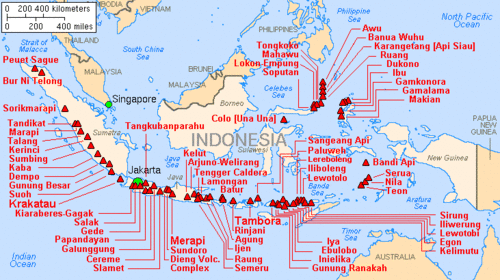
Indonesia is a volcanically active country, containing numerous major volcanoes. With 76 volcanoes that have erupted at least 1,171 times in total within historical times. [1] [2] [3] The Smithsonian Institution has 141 Indonesian entries in its volcano database. [4] Indonesia has around 130 active volcanoes that are part of the Pacific Ring of Fire, and it has suffered the highest numbers of eruptions resulting in fatalities, damage to arable land, debris flows, tsunamis, lava domes, and pyroclastic flows. Indonesia's most active volcanoes are Kelut and Mount Merapi on the island of Java. The majority of Indonesia's volcano are located on a 3,000 km long chain called the Sunda Arc. Here, the subduction of the Indian Ocean crust underneath the Asian Plate produced most of these volcanoes. [5]